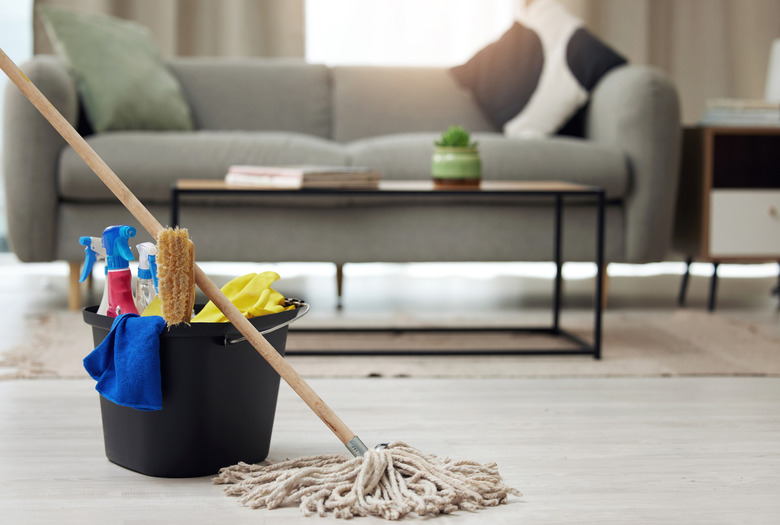How To Remove Mop & Glo Buildup
We may receive a commission on purchases made from links.
Mop & Glo floor wax is intended to clean and shine your floors. It doesn't actually contain wax; it uses an acrylic coating to produce its shine. Over time, the thin layer of acrylic left behind after cleaning the floor begins to build up and may even discolor the surface, defeating the purpose of the product. The best thing to do is to remove the buildup and start fresh with the manufacturer's recommended cleaning and/or clean-and-shine products.
Mop & Glo Cautions and Precautions
Mop & Glo Cautions and Precautions
Always read the label carefully before using Mop & Glo or any other product on your flooring to ensure that you don't accidentally damage the surface. Using anything other than the recommended cleaning products on a floor may void the warranty. However, if Mop & Glo, Orange Glo floor cleaner, or any other shine-producing product has already been applied, there are several ways to remove the buildup.
Before you begin, protect your skin and eyes by putting on gloves and safety goggles. Open the windows and turn on the kitchen or bathroom fan to pull out any smells or fumes produced during the cleaning process. Also sweep or vacuum the floor to remove loose dirt, sand, and debris.
Remove Mop & Glo Floor Wax
Remove Mop & Glo Floor Wax
To remove the layers of acrylic buildup, combine 1/4 cup Lysol, 1 cup ammonia, and 1/2 gallon warm water in a bucket. Do not use any products containing chlorine bleach; combining bleach and ammonia produces a toxic gas that can damage your lungs and may prove fatal in a severe situation. Check the ingredient list on the Lysol label for sodium hypochlorite, which is the scientific name for chlorine bleach.
Test the cleaning solution in an inconspicuous corner to ensure that it only removes the buildup. Spread the solution over the floor in 3 x 3-foot sections, let it soak in for five minutes, and then wipe with a clean rag or sponge to remove the residue. Rinse with clean water.
If the buildup proves difficult to remove, repeat the cleaning process using 2 cups of ammonia per gallon of warm water. Spread it over a section of the floor, wait five minutes, and then use a nylon scrubber, scrub brush, plastic putty knife, or — to save your knees and back — a long-handled scrubber or similar product to scrub and scrape off the residue. Rinse the scrubber regularly to remove the dissolved acrylic product. Rinse the floor with clean water and allow it to dry.
Clean With Vinegar
Clean With Vinegar
If you can't tolerate ammonia or Lysol, consider using vinegar as a cleaner. Mix 1/2 cup of white vinegar with 1/2 gallon of water and mop the floor. Rinse the mop often as you work to help remove dirt and dull, greasy films. In general, Mop & Glo won't ruin your floors, but it may not work quite as you had expected.
Use a Floor Stripper and Cleaner
Use a Floor Stripper and Cleaner
There are also a number of floor-stripping and cleaning products available for use on vinyl flooring. Products such as Armstrong New Beginning Floor Stripper and Cleaner are specifically formulated to remove the buildup of wax and polish from no-wax vinyl floors without further damaging the floor's surface. Whatever floor stripper and cleaner you choose, read the label carefully to ensure that you are using the correct product for your type of flooring, whether it's no-wax vinyl, laminate, hardwood, or tile, and follow the directions exactly for best results.
